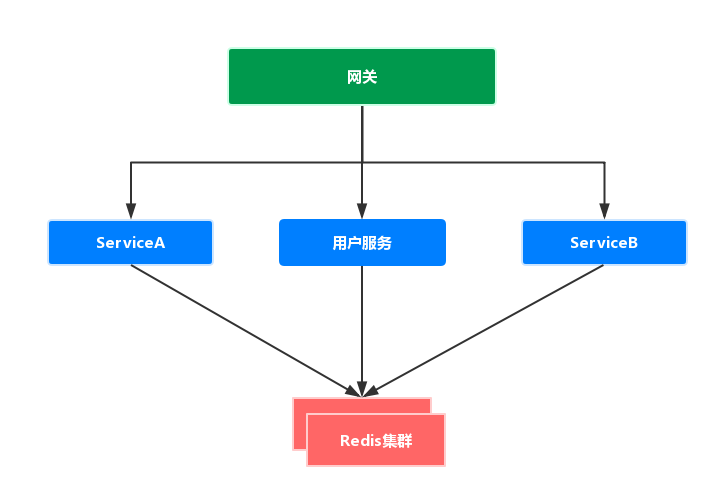基于 Spring Session & Spring Security 微服务权限控制

微服务架构

- 网关:路由用户请求到指定服务,转发前端 Cookie 中包含的 Session 信息;
- 用户服务:用户登录认证(Authentication),用户授权(Authority),用户管理(Redis Session Management)
- 其他服务:依赖 Redis 中用户信息进行接口请求验证
用户 - 角色 - 权限表结构设计
- 权限表
权限表最小粒度的控制单个功能,例如用户管理、资源管理,表结构示例:
| id | authority | description |
|---|---|---|
| 1 | ROLE_ADMIN_USER | 管理所有用户 |
| 2 | ROLE_ADMIN_RESOURCE | 管理所有资源 |
| 3 | ROLE_A_1 | 访问 ServiceA 的某接口的权限 |
| 4 | ROLE_A_2 | 访问 ServiceA 的另一个接口的权限 |
| 5 | ROLE_B_1 | 访问 ServiceB 的某接口的权限 |
| 6 | ROLE_B_2 | 访问 ServiceB 的另一个接口的权限 |
- 角色 - 权限表
自定义角色,组合各种权限,例如超级管理员拥有所有权限,表结构示例:
| id | name | authority_ids |
|---|---|---|
| 1 | 超级管理员 | 1,2,3,4,5,6 |
| 2 | 管理员A | 3,4 |
| 3 | 管理员B | 5,6 |
| 4 | 普通用户 | NULL |
- 用户 - 角色表
用户绑定一个或多个角色,即分配各种权限,示例表结构:
| user_id | role_id |
|---|---|
| 1 | 1 |
| 1 | 4 |
| 2 | 2 |
用户服务设计
Maven 依赖(所有服务)
<!-- Security -->
<dependency>
<groupId>org.springframework.boot</groupId>
<artifactId>spring-boot-starter-security</artifactId>
</dependency>
<!-- Spring Session Redis -->
<dependency>
<groupId>org.springframework.session</groupId>
<artifactId>spring-session-data-redis</artifactId>
</dependency>
应用配置 application.yml 示例:
# Spring Session 配置 spring.session.store-type=redis server.servlet.session.persistent=true server.servlet.session.timeout=7d server.servlet.session.cookie.max-age=7d # Redis 配置 spring.redis.host=<redis-host> spring.redis.port=6379 # MySQL 配置 spring.datasource.driver-class-name=com.mysql.jdbc.Driver spring.datasource.url=jdbc:mysql://<mysql-host>:3306/test spring.datasource.username=<username> spring.datasource.password=<passowrd>
用户登录认证(authentication)与授权(authority)
@Slf4j
public class CustomAuthenticationFilter extends AbstractAuthenticationProcessingFilter {
private final UserService userService;
CustomAuthenticationFilter(String defaultFilterProcessesUrl, UserService userService) {
super(new AntPathRequestMatcher(defaultFilterProcessesUrl, HttpMethod.POST.name()));
this.userService = userService;
}
@Override
public Authentication attemptAuthentication(HttpServletRequest request, HttpServletResponse response) throws AuthenticationException {
JSONObject requestBody = getRequestBody(request);
String username = requestBody.getString("username");
String password = requestBody.getString("password");
UserDO user = userService.getByUsername(username);
if (user != null && validateUsernameAndPassword(username, password, user)){
// 查询用户的 authority
List<SimpleGrantedAuthority> userAuthorities = userService.getSimpleGrantedAuthority(user.getId());
return new UsernamePasswordAuthenticationToken(user.getId(), null, userAuthorities);
}
throw new AuthenticationServiceException("登录失败");
}
/**
* 获取请求体
*/
private JSONObject getRequestBody(HttpServletRequest request) throws AuthenticationException{
try {
StringBuilder stringBuilder = new StringBuilder();
InputStream inputStream = request.getInputStream();
byte[] bs = new byte[StreamUtils.BUFFER_SIZE];
int len;
while ((len = inputStream.read(bs)) != -1) {
stringBuilder.append(new String(bs, 0, len));
}
return JSON.parseObject(stringBuilder.toString());
} catch (IOException e) {
log.error("get request body error.");
}
throw new AuthenticationServiceException(HttpRequestStatusEnum.INVALID_REQUEST.getMessage());
}
/**
* 校验用户名和密码
*/
private boolean validateUsernameAndPassword(String username, String password, UserDO user) throws AuthenticationException {
return username == user.getUsername() && password == user.getPassword();
}
}
@EnableWebSecurity
@AllArgsConstructor
public class WebSecurityConfig extends WebSecurityConfigurerAdapter {
private static final String LOGIN_URL = "/user/login";
private static final String LOGOUT_URL = "/user/logout";
private final UserService userService;
@Override
protected void configure(HttpSecurity http) throws Exception {
http.authorizeRequests()
.antMatchers(LOGIN_URL).permitAll()
.anyRequest().authenticated()
.and()
.logout().logoutUrl(LOGOUT_URL).clearAuthentication(true).permitAll()
.and()
.csrf().disable();
http.addFilterAt(bipAuthenticationFilter(), UsernamePasswordAuthenticationFilter.class)
.rememberMe().alwaysRemember(true);
}
/**
* 自定义认证过滤器
*/
private CustomAuthenticationFilter customAuthenticationFilter() {
CustomAuthenticationFilter authenticationFilter = new CustomAuthenticationFilter(LOGIN_URL, userService);
return authenticationFilter;
}
}
其他服务设计
应用配置 application.yml 示例:
# Spring Session 配置 spring.session.store-type=redis # Redis 配置 spring.redis.host=<redis-host> spring.redis.port=6379
全局安全配置
@EnableWebSecurity
public class WebSecurityConfig extends WebSecurityConfigurerAdapter {
@Override
protected void configure(HttpSecurity http) throws Exception {
http.authorizeRequests()
.anyRequest().authenticated()
.and()
.csrf().disable();
}
}
用户认证信息获取
用户通过用户服务登录成功后,用户信息会被缓存到 Redis,缓存的信息与 CustomAuthenticationFilter 中 attemptAuthentication() 方法返回的对象有关,如上所以,返回的对象是 new UsernamePasswordAuthenticationToken(user.getId(), null, userAuthorities) ,即 Redis 缓存了用户的 ID 和用户的权力(authorities)。
UsernamePasswordAuthenticationToken 构造函数的第一个参数是 Object 对象,所以可以自定义缓存对象。
在微服务各个模块获取用户的这些信息的方法如下:
@GetMapping()
public WebResponse test(@AuthenticationPrincipal UsernamePasswordAuthenticationToken authenticationToken){
// 略
}
权限控制
- 启用基于方法的权限注解
@SpringBootApplication
@EnableGlobalMethodSecurity(prePostEnabled = true, securedEnabled = true)
public class Application {
public static void main(String[] args) {
SpringApplication.run(Application.class, args);
}
}
- 简单权限校验
例如,删除角色的接口,仅允许拥有 ROLE_ADMIN_USER 权限的用户访问。
/**
* 删除角色
*/
@PostMapping("/delete")
@PreAuthorize("hasRole('ADMIN_USER')")
public WebResponse deleteRole(@RequestBody RoleBean roleBean){
// 略
}
@PreAuthorize("hasRole('<authority>')") 可作用于微服务中的各个模块
- 自定义权限校验
如上所示, hasRole() 方法是 Spring Security 内嵌的,如需自定义,可以使用 Expression-Based Access Control ,示例:
/**
* 自定义校验服务
*/
@Service
public class CustomService{
public boolean check(UsernamePasswordAuthenticationToken authenticationToken, String extraParam){
// 略
}
}
/**
* 删除角色
*/
@PostMapping()
@PreAuthorize("@customService.check(authentication, #userBean.username)")
public WebResponse custom(@RequestBody UserBean userBean){
// 略
}
authentication 属于内置对象, # 获取入参的值
- 任意用户权限动态修改
原理上,用户的权限信息保存在 Redis 中,修改用户权限就需要操作 Redis,示例:
@Service
@AllArgsConstructor
public class HttpSessionService<S extends Session> {
private final FindByIndexNameSessionRepository<S> sessionRepository;
/**
* 重置用户权限
*/
public void resetAuthorities(Long userId, List<GrantedAuthority> authorities){
UsernamePasswordAuthenticationToken newToken = new UsernamePasswordAuthenticationToken(userId, null, authorities);
Map<String, S> redisSessionMap = sessionRepository.findByPrincipalName(String.valueOf(userId));
redisSessionMap.values().forEach(session -> {
SecurityContextImpl securityContext = session.getAttribute(HttpSessionSecurityContextRepository.SPRING_SECURITY_CONTEXT_KEY);
securityContext.setAuthentication(newToken);
session.setAttribute(HttpSessionSecurityContextRepository.SPRING_SECURITY_CONTEXT_KEY, securityContext);
sessionRepository.save(session);
});
}
}
修改用户权限,仅需调用 httpSessionService.resetAuthorities() 方法即可,实时生效。
- 本文标签: tar id redis stream list rmi message servlet 安全 权限控制 App build authenticate js IO UI 微服务 value logo Word cat token CTO dataSource 认证 https bean 配置 缓存 key mysql 删除 maven description springboot 管理 final web struct Service map JDBC json http db find Spring Security IDE 参数 spring ip Security sql session parse src tab
- 版权声明: 本文为互联网转载文章,出处已在文章中说明(部分除外)。如果侵权,请联系本站长删除,谢谢。
- 本文海报: 生成海报一 生成海报二











![[HBLOG]公众号](https://www.liuhaihua.cn/img/qrcode_gzh.jpg)

